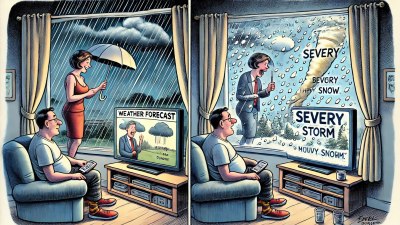Why the Forecast Always Promises Excitement but Gives You the Same Old Weather
Explore the paradox of weather forecasting and its tendency to deliver less than thrilling outcomes despite high expectations.

This image was created with the assistance of DALL·E
Weather forecasting is a science that has captivated humanity for centuries, offering the promise of excitement and the anticipation of what tomorrow might bring. With the advent of technology and sophisticated modeling, one would expect forecasts to provide thrilling deviations from the ordinary, yet, time and again, they seem to deliver the same old weather. This paradox raises fascinating questions about the nature of weather predictions, the expectations set by meteorologists, and the inherent variability of our atmosphere.
The history of weather forecasting dates back to ancient civilizations, where people relied on observations of natural phenomena to predict the weather. As societies evolved, so did the methods of forecasting. Today, meteorologists utilize a complex array of tools, including satellites, radar, and computer models, to predict atmospheric changes. Yet, despite these advancements, why does the weather often feel monotonous?
The Science of Weather Prediction
At its core, weather forecasting relies on understanding the vast and intricate system of atmospheric processes. Meteorologists analyze data from ground-based stations, weather balloons, and satellite imagery to create models that simulate the behavior of the atmosphere. These models take into account multiple variables, including temperature, humidity, wind direction, and atmospheric pressure, to predict weather patterns.
However, weather systems are highly dynamic, with countless variables that can change rapidly. This complexity makes it challenging to generate accurate long-term forecasts. While short-term predictions (up to 48 hours) tend to be relatively reliable, predicting weather weeks or months in advance is fraught with uncertainty. Even with advanced models, the atmosphere's inherent chaos can lead to unexpected outcomes, often resulting in forecasts that oscillate between excitement and disappointment.
The Psychology of Expectations
The gap between forecast excitement and actual weather experiences can also be attributed to psychological factors. When meteorologists announce a possible storm or a significant weather event, the media often amplify these predictions, highlighting the potential for dramatic weather changes. This hype can create a sense of anticipation among the public, leading to heightened expectations.
However, when the actual weather fails to meet those expectations—when a promised storm turns out to be a light drizzle, for example—it can lead to feelings of disappointment. The human psyche is wired to seek novelty and excitement, and when the weather remains stable or ordinary, it clashes with our desires for change and adventure. This psychological disconnect can make even a simple rainy day feel underwhelming after a forecast of heavy rainfall.
Media Influence and the Forecasting Narrative
The role of the media in shaping public perception of weather forecasts cannot be overstated. News outlets often sensationalize weather events to attract viewers and generate interest. When a cold front or heat wave approaches, headlines may read, “Brace for Impact!” or “Extreme Weather Coming Our Way!” These dramatic descriptions can set the stage for audiences to anticipate a thrilling weather event.
Yet, when the forecast does not deliver the promised excitement, viewers may feel let down. The cycle of hype and realization can lead to a lingering sense of distrust in weather forecasts, as people become conditioned to expect grand weather happenings that fall flat. In this way, the narrative surrounding weather forecasting can sometimes overshadow the realities of the intricate science behind it.
The Challenge of Communication
Effective communication of weather forecasts is essential in bridging the gap between expectations and reality. Meteorologists face the challenge of conveying complex information in a digestible format while also remaining truthful about the inherent uncertainties of forecasting. A forecast may contain a range of possibilities—such as a 40% chance of rain—but the public often focuses on the possibility that aligns with their hopes or fears.
This selective perception can lead to misunderstandings about what a forecast truly means. For instance, when a 30% chance of rain is communicated, many may interpret it as “there won’t be rain,” while it actually indicates that in similar weather conditions, rain occurred in 30 out of 100 instances. This misinterpretation can further contribute to feelings of disappointment when weather conditions do not match expectations.
With advancements in technology, weather forecasting has progressed significantly over the last few decades. High-resolution models and real-time data processing enable meteorologists to produce more accurate short-term forecasts. Technologies such as Doppler radar allow for the detection of precipitation and storm patterns with remarkable precision. As a result, daily weather updates feel more urgent and exciting.
However, this focus on short-term forecasting can overshadow the inherent limitations of long-term predictions. While technology has undoubtedly improved forecasting capabilities, it cannot eliminate the unpredictability of the atmosphere. The challenge remains in striking a balance between leveraging technological advances and communicating the uncertainties that persist in forecasting.
Climate Change and its Impact on Weather Patterns
The effects of climate change are also shaping the landscape of weather forecasts. As global temperatures rise, weather patterns become increasingly erratic, leading to unprecedented events. While climate change may infuse unpredictability into forecasting, it can also create opportunities for excitement in terms of experiencing novel weather phenomena.
For instance, areas that traditionally experience mild winters may face extreme cold snaps, while regions with historically stable rainfall patterns may encounter severe droughts or unexpected floods. While these extreme weather events can deliver the excitement that forecasts promise, they also come with significant risks and consequences for communities and ecosystems.
Embracing the Ordinary
In a world constantly seeking novelty, the emphasis placed on the sensational aspects of weather can overshadow the beauty and significance of ordinary weather days. There is a certain charm in predictability—understanding that sunny days will follow rainy ones or that seasonal changes occur in a rhythmic pattern. These ordinary moments hold their unique excitement, even if they may not command headlines.
Weather forecasts, while often disappointing in the realm of excitement, serve an essential purpose: they prepare us for the variability of life. Whether it’s planning for an outdoor event or deciding to stay cozy inside, the anticipation of what the weather holds can influence our daily activities and decisions.
Conclusion
The promise of excitement in weather forecasts is a complex tapestry woven from the threads of scientific understanding, psychological expectations, media influence, and the unpredictable nature of the atmosphere. While forecasts may not always deliver the thrilling weather events we hope for, they remain an invaluable tool in our understanding of the world around us. Rather than solely seeking sensational weather changes, embracing the beauty of ordinary patterns and daily fluctuations can lead to a more profound appreciation for the dynamics of our climate. In a world where change is constant, the predictability of the weather becomes a comforting reality, reminding us that even amidst monotony, there is beauty to be found in simplicity.











